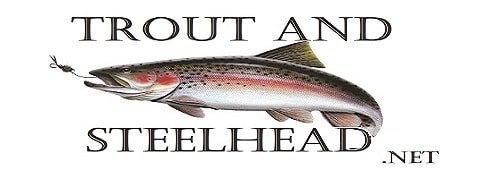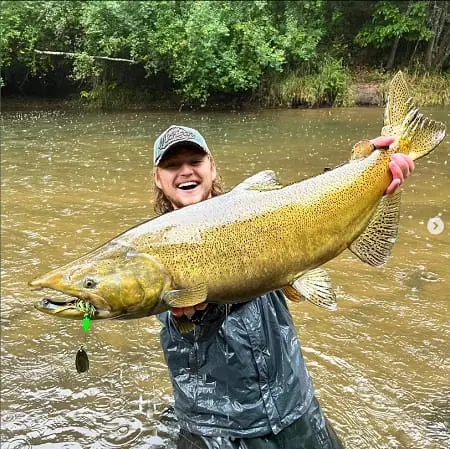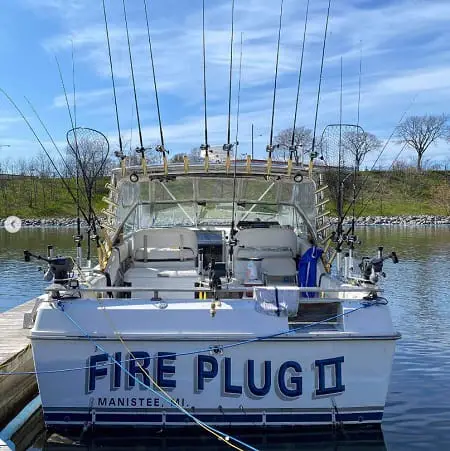Salmon Fishing In Michigan: Tips And Advice From The Guides
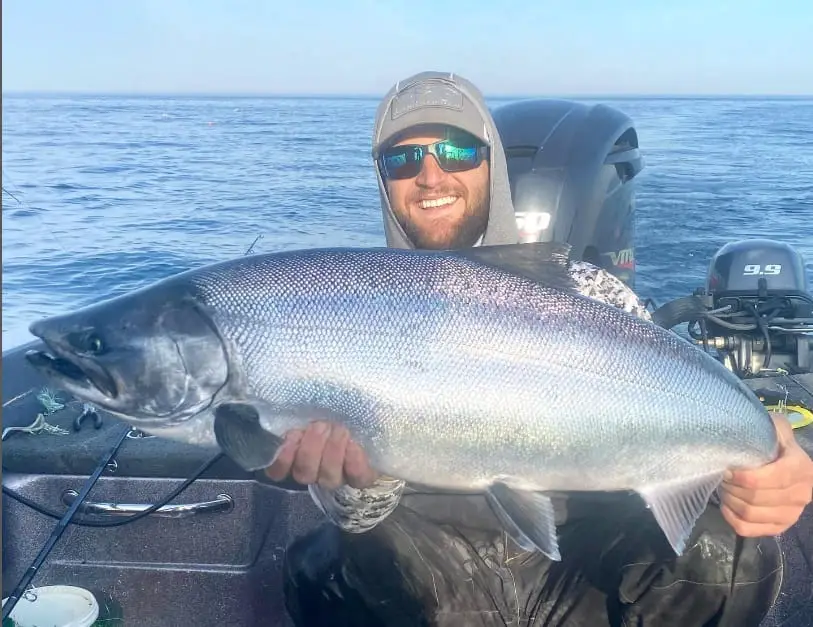
With the help of our Michigan salmon fishing guides, this is the most complete guide on Catching salmon in Michigan, both on the rivers and the lake. Our guides give you their tactics, advice, and tips to help you have a better experience fishing for Michigan Salmon.
Salmon fishing in Michigan rivers starts in September and ends in November, but anglers can catch salmon 12 months of the year. Anglers have many great rivers and streams to try and two Great Lakes with four types of salmon.
Michigan salmon fishing is a great opportunity for anglers to catch multiple salmon over 20 pounds.
Types Of Salmon Fishing In Michigan
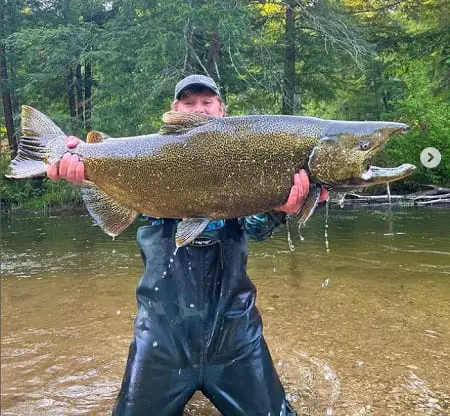
There are three types of salmon fishing in Michigan.
- There is open lake fishing where anglers troll from boats.
- There is near-shore lake fishing, where anglers will target salmon from piers and shorelines.
- River fishing is the most popular once the salmon enter rivers to spawn.
With all of these types of fishing, anglers can target these salmon species:
- Chinook salmon
- Coho salmon
- Pink salmon
- Atlantic salmon
Michigan Salmon
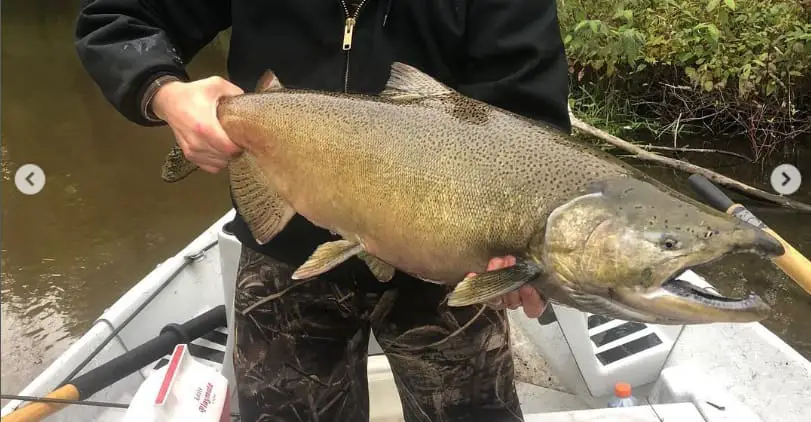
Chinook Salmon – also known as kings or king salmon due to their size, they are often the earliest of the salmon to enter the rivers. They are sometimes followed by rainbow trout and Great Lakes migratory brown trout.
September and October are prime months on most rivers, but on some rivers and under the right conditions, some chinook salmon will run up colder rivers in August.
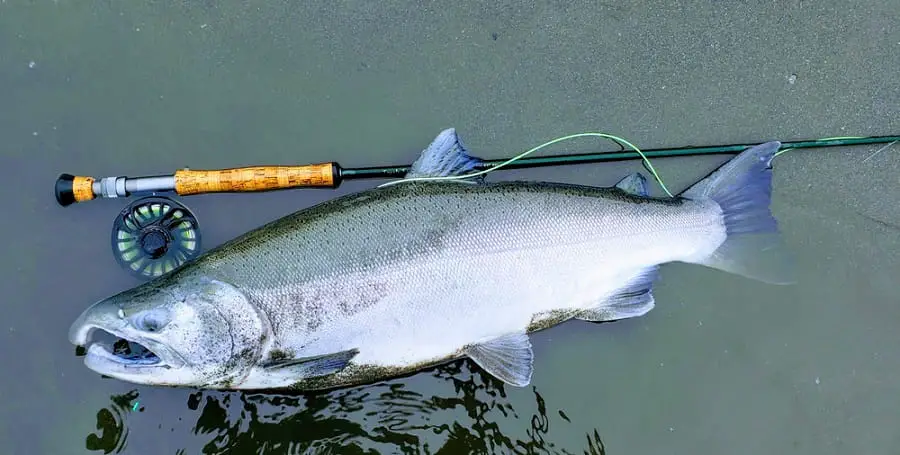
Coho Salmon – also known as silver salmon, or silvers, are well-known for fighting and bone-jarring strikes.
Coho is the second species of salmon to enter the rivers, making October and early November prime silver salmon months.
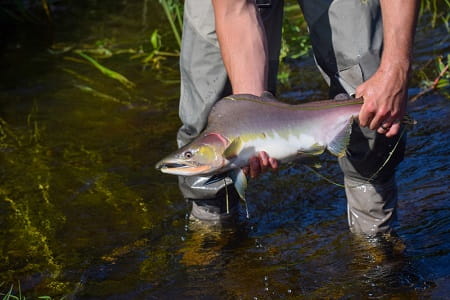
Pink Salmon – The pink salmon is the smallest of the salmon species with an average size between 3 and 5 pounds. The best times for pink salmon fishing are June and July.
They do not swim far upstream to spawn but they do prefer fast flowing cold and clean streams.
A top river for pink salmon is the St Marys River which some anglers call the best pink salmon fishing in the east. Pink salmon are more prevalent in Northern Michigan but are rare compared to king salmon and coho salmon.
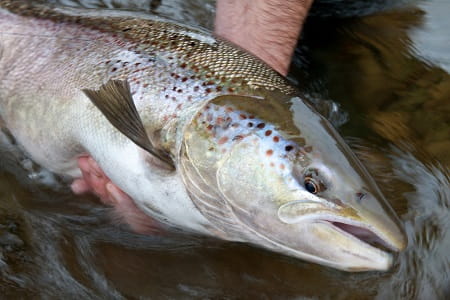
Atlantic Salmon – Michigan Atlantic Salmon start to enter some rivers as early as July and will spawn in October and November.
They are found from the St Clair River to the St Marys River, with some of the best fishing On the St Mary’s River, Thunder Bay River, and the AuSable River.
These rivers have good numbers of Atlantic salmon by October.
There is also a good fishery in Torch Lake. They are the second largest of the salmon species in Michigan. Anglers might also catch them while trolling out in Lake Huron.
How Big Do Salmon Get in Michigan?
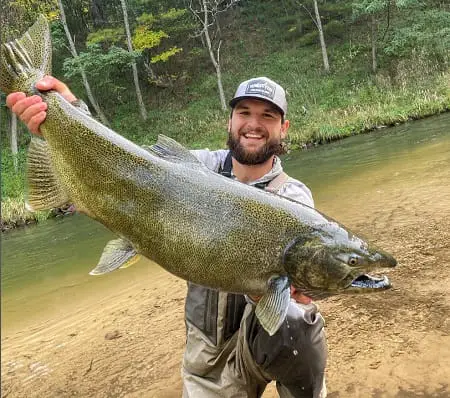
Michigan salmon records are as follows but average salmon are about half these sizes.
- Coho – 30.56 pounds
- Chinook – 40.4 pounds
- Pink – 8.56 pounds
- Atlantic – 32.62
Lake Fishing For Salmon:
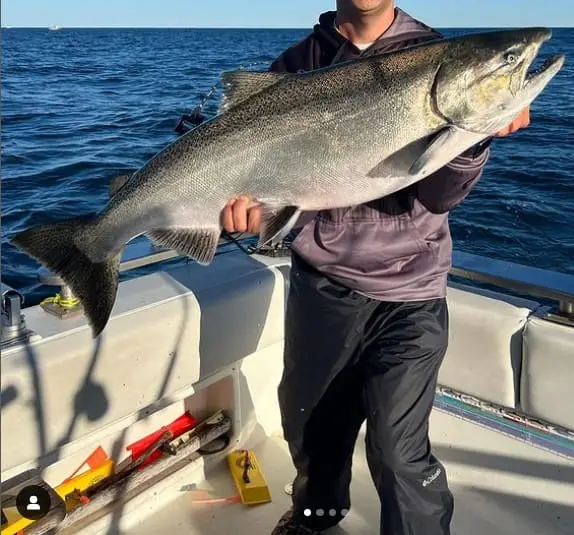
Salmon fishing charters are one of the best ways to experience salmon fishing on Michigan lakes, but anglers with suitable boats and the right gear for the big lake can do very well on their own.
The state of Michigan has Lake Huron on its east, lake Michigan on its west, and Lake Huron to the north, and all areas have good salmon fishing.
These two lakes have unique structures, and the salmon use different parts of the lake at different times so anglers have the opportunity to fish with spinning rods, bait casters, or fly rods.
For open lake fishing, the most common method is trolling for salmon.
Shore fishing can also be very good for salmon. Shore fishing for Michigan salmon is usually done with plunking techniques or casting lures, both of which can work well when lake fishing for salmon.
Trolling For Michigan Salmon
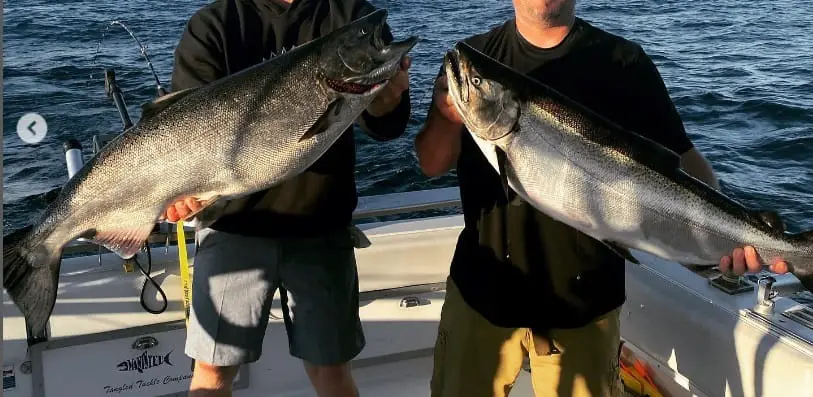
Most anglers troll for salmon using shiny spoons, cut baits, or trolling flies. When the salmon are staging around the river mouths in spring and late summer, plugs and crankbaits can be the hottest lures.
Generally, May, June, and July are when the salmon will be out in the open water and will often be deeper than 60 feet down. This is when trolling with downriggers is about the only way you will have any success.
Shore Fishing For Michigan Salmon
Many anglers will try shore fishing if they don’t have access to a boat,, and at times, this is a great way to fish for Michigan salmon.
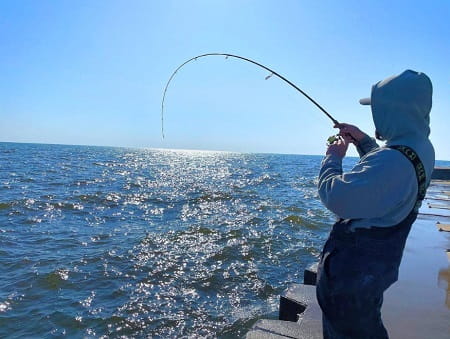
If you know where the salmon are and how to follow their seasonal migrations, you can fish from shore with some success, especially during the spring and fall months when the salmon are higher in the water column and will often congregate near river mouths, bays, or warm water discharges.
Local anglers and guides will know where these areas are and will cast lures or plunk baits out in the lake. Some will also use baits under a slip float. Pier fishing and river mouths are often the hot spots.
Starting in late August through September and even in October, many salmon will stage close to the river mouths, and some will even move in and out of the lower sections of the rivers in the dark or low light conditions, waiting for ideal river conditions.
For more detailed info on Lake Michigan fishing for all species, check out: Lake Michigan Fishing: 3 Top Guides Tell You How And Where.
Lure Fishing For Michigan Salmon
Lure fishing is common on the lake, also at river mouths, and when the salmon are in the river. Salmon will hit lures at any time and anywhere.
Out in the lake and when the salmon first enter the rivers, they are hitting lures because they are feeding.
Once the salmon have been in the river for 24 hours or more, their focus turns to getting up the river and spawning.
When this happens, the salmon will hit lures out of aggression, habit, or instinct, and some will also hit a lure because it’s in their spawning territory.
There are many salmon guides in the rivers that will use lures due to their effectiveness and because of the hard hits and the excitement it provides their clients.
Lures also work for trolling in the lake, for back trolling in the rivers, and also from the shore, whether that shore is the bank of the river, the beaches, or the shoreline of the lake.
Best Types Of Lures For Salmon
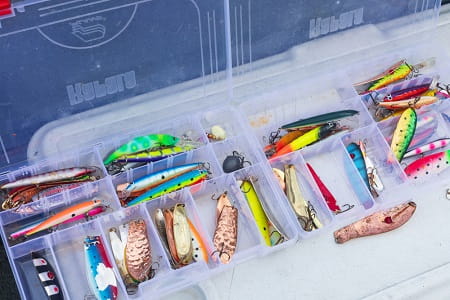
Lures of various sizes, colors, and types, including spoons, crankbaits, plugs, and spinners, work for salmon.
Spoons
There are two types of spoons that anglers use to fish for Michigan salmon. Flutter or trolling spoons are lightweight, have good action, and are the preferred choice for boat anglers.
Casting spoons such as Little Cleos and Krocodiles are heavier spoons that can be cast long distances out into the lake. They are also good for river fishing because they stay down even in faster currents, which I discuss on my page, Lure Fishing For Salmon.
Plugs and Crankbaits For Michigan Salmon
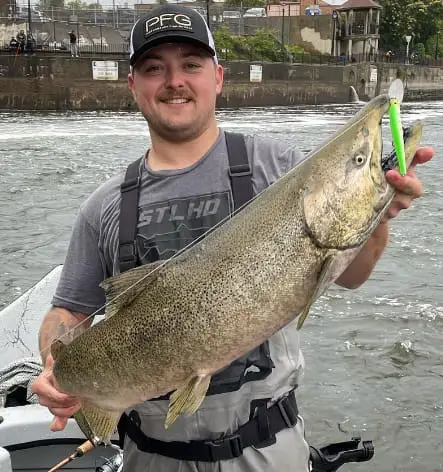
Salmon plugs are big lures that wobble, make noises, or dive.
These can be cast or trolled and anglers will often use these early in the spring or late summer and fall when the salmon are stagging near the mouths of rivers or inthe rivers.
These plugs have enticing wobbles that trigger salmon to bite.
Cranbaits like the Storm Thunderstick, or plugs like the Kwickfish, Flatfish, and Mag lips are popular and effective.
Colors can be similar to summer spoon colors, but chartreuse, greens, and silver are general go-to colors.
A good tip is to choose crankbaits in brighter colors, silver, medium blue, greens, pinks, and black.
Spinners For Michigan Salmon
Spinners such as Mepps, Blue Fox, and Panther Martins are very good for salmon at the river mouths and up in the rivers. Bright colored spinners are a top choice for many guys that like casting lures for salmon.
I discuss all of these lures and the best colors on my page, Best Lures For Salmon.
Jigging For Salmon
A lesser known but very effective method is jig fishing for salmon. Jigs can be used near shore at the pier and river mouths or in the river.
Anglers can cast jigs using a method known as twitching jigs. Jigs can also be drifted under a float or with drift fishing methods.
For the best salmon jigs and for more information on this method, check out my page, Jig Fishing For Salmon.
River Fishing For Salmon In Michigan
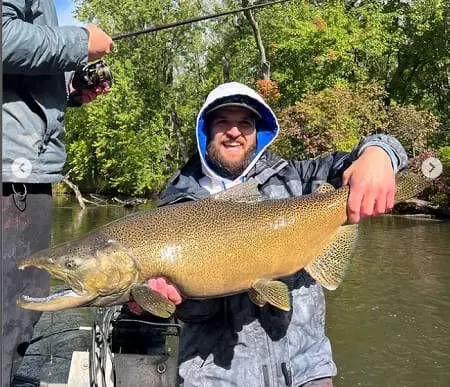
River fishing for salmon in Michigan is a fall event. The salmon enter the rivers in September and October. It starts with small runs occurring in late August after big rains.
The run times will differ based on the river and the salmon species. Here are a few examples:
Anglers have the option to fish miles of each river, which could be from the mouth of the river to the headwaters minus any private property:
- Manistee River – Early season begins the first week of September and stretches through mid-October. Early kings are common with sight fishing opportunities. Tippy Dam is a good place for trout fishing, especially for Lake Trout during salmon run times.
- Grand River – September to mid-November are the run times for salmon with early kings and lots of trout. The Sixth Street Bridge is a hot spot, but overcrowding is easy.
- White River – September and October are run times for salmon. Rainbow and brown trout are always an option, and steelhead fishing from November. Great for short floats or wading.
- Saint Marys River – late June for early Atlantic salmon. Late September for Coho and king salmon and plenty of opportunity for steelhead in early October and musky in early October.
- St. Joseph River – A bigger river with good runs of summer, fall, and spring steelhead combined with fall salmon.
- Pere Marquette River – August – late September – You can also target brown trout and steelhead here.
- Lake Huron Tributaries – Mid-September and into October – Sometimes later. You can target trout, walleye, and steelhead here too.
- Big Manistee River
- Muskegon River
- Two-Hearted River
- Clinton River
- Kalamazoo River
Options For River Fishing Salmon
Walk and Wade is one method used by most anglers, especially if you don’t have a boat. There are many public access areas along most rivers.
A better option is to drift the rivers by boat which can get you away from crowds and into a lot more salmon that are not bothered by other anglers. Inflatable portable river boats can also get you through miles of private property sections that other anglers on foot can’t access. This often means more fish.
A guided drift boat or walk trip is money well spent, especially if you do not know the river or the methods yet. A good river guide will take care of the drop-off and pick-up options and all you have to do is focus on the fishing and learning how the guides do it.
What Month Do Salmon Run In Michigan?
If you are a do-it-yourself kind of angler, knowing when to hit the river is a big part of catching salmon in Michigan.
Generally, the salmon season in Michigan begins in May for boat anglers and for many pier fishermen, and it ends in late October or sometimes into November for the river anglers.
Salmon fishing crosses with steelhead fishing at times, but the steelhead is a prime target in winter when salmon fishing takes the back burner.
Best Methods For Catching Salmon In Michigan
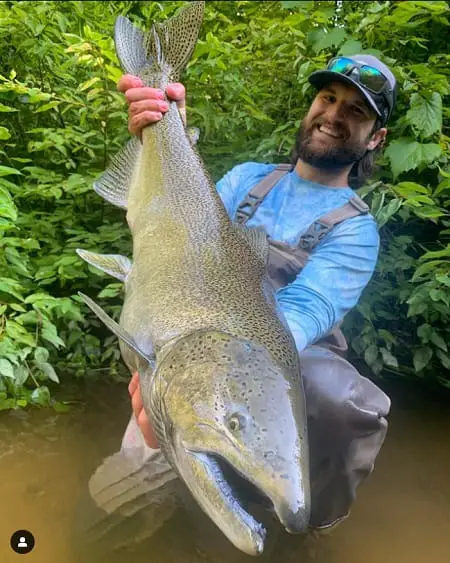
Float Fishing: Float fishing with spinning reels or baitcasting reels is a method where you suspend your bait below a float (also known as a bobber) and drift long stretches of the river.
This is very popular and often the most effective method in rivers.
For more info, see Float Fishing For Salmon.
Centerpin fishing – is a natural presentation for bait or flies under a float using a reel known as a Centerpin reel or a Float reel. There is no drag on this unique reel so you have to wear the fish out with hand or finger pressure on the reel.
Centerpin fishing is often the most effective method for salmon and steelhead. See my page Centerpin Fishing For Salmon for more information.
Fly fishing – Fly fishing using Nymphs or Streamers is very popular and very effective on Michigan salmon, especially in rivers. Some anglers will fly fish from piers and the shores.
Many of the Michigan rivers are also large and well suited for a fly fishing method known as Spey Fishing. Check out my page Fly Fishing For Salmon and Nymphing For Salmon.
Best Flies For Michigan Salmon
- Woolly Bugger in black, olive, and white
- Egg Sucking Leech – Black, purple or olive body with red, orange, and pink egg-head
- Glo Bug – Egg pattern – Change colors based on water clarity, but often pink, chartreuse, and yellow or hot.
- General egg pattern flies – often in a range of colors from yellow to vivid green.
- Streamers in bright, hot colors – pinks, yellows, oranges, and cooler tones, blue to black.
See over 40 of the most effective salmon flies.
Casting lures – spinning rods and reels are easy to use for most beginners and many experienced anglers. You can fish from shore or a boat.
Drift Fishing And Bottom Bouncing – These are similar methods where you simply cast your bait out and allow it to sink and drift along the river bottom with the current.
The Drift Fishing method is better suited to larger and deeper sections of the river, as well as longer drifts, and the Bottom Bouncing method is great for smaller pocket water, shallower water, and smaller sections where shorter drifts are required.
These methods use an assortment of baits.
Plunking – Plunking is another method used for salmon in rivers and lake.
Plunking allows you to cast your bait out and have it hold in a specific zone where salmon are likely to swim by and grab your bait. This is an easy method for new anglers and is very relaxing. Anglers will mostly use organic bait such as spawn bags, shrimp, worms, or minnows. For more on this method, check Out Plunking For Salmon.
Bobber Doggin – Bobber Doggin is a somewhat new. It’s similar to float fishing with the difference in the setup and how you let your bobber drift. For more on this method, check out Bobber Doggin.
Best Baits For Michigan Salmon
The top option for many anglers fishing for Michigan salmon are salmon egg sacks.
Learn guide tricks and methods they use to make their spawn bags more effective on my page Spawn Bags: Guide Tips
Beads and pink worms are other good baits. Check out all my most effective baits on my page, Best Salmon Baits.
How Many Salmon Can You Keep In Michigan?
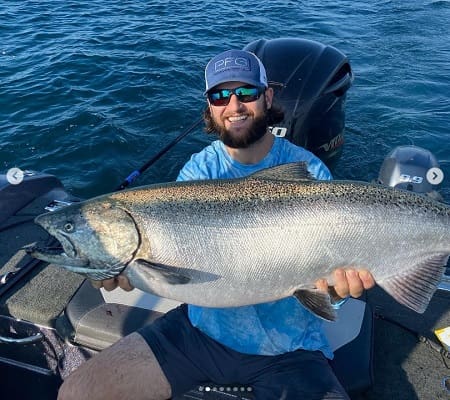
Generally, and at the time of this publication, up to five salmon per day and no more than three Atlantic salmon, however, these rules change each year so be sure to read up on the local rules for each fishery.
Fishing Regulations And Fishing Licence
All fishing regulations are available online. Fishing licenses can be ordered online at local tackle shops. Michigan also has an app for hunting and fishing that allows you to check the regulations, access maps, and more.
Michigan Salmon Fishing Lodges
- Batche’s Manistee River Lodge – A fly fishing lodge with guided adventures for trout and salmon. Fish the Manistee River, Pere Marquette River, Bear Creek, and the Pine River.
- North Rivers Lodge – fly fishing on the Little Manistee River. Restored log cabins are full of rustic charm and set amid the beauty of the Manistee National Forest.
- The Homestead – on the shores of Lake Michigan – Is a family resort with a focus on fishing and local fun.
Michigan Salmon Fishing Guides
- Get Bent Guide Service – a well-reviewed and professional guide for salmon, steelhead, and trout on Southern Lake Michigan rivers.
- Fire Plug Charters – Manistee River, Muskegon River, and Lake Michigan- Salmon, trout, steelhead, and bass. Well-reviewed, award-winning, and very professional
Lake Michigan’s Best Salmon Charters
- Fire Plug Charters – West Michigan salmon and trout fishing – Fish Salmon on Lake Michigan. Very experienced and knowledgeable about current fishing data.
Michigan Fishing Reports
An excellent resource for anglers is the Weekly Fishing Report by the State of Michigan. It helps you know what’s running and where.
These are some common questions about Michigan Salmon Fishing.
Do you need a special license to fish for salmon in Michigan?
You need a Salmon and Trout Stamp, along with the normal fishing license, which is required when targeting most fish, including salmon in Michigan. Michigan’s annual fishing license is valid from March 1 of a given year through March 31 of the following year. This may change, so be sure to check the official fishing regulations.
How Much Is A Michigan Salmon Fishing Licence?
It depends if you are a resident, which is $26, A non-resident, which is $76, or a Senior resident which is $11. However, these prices may change every year so check the official fishing regulations.
How Much Is A Salmon Stamp In Michigan?
As of now, a salmon stamp is $6.50, this may change so check the official regulations.
Tight Lines,
Graham
